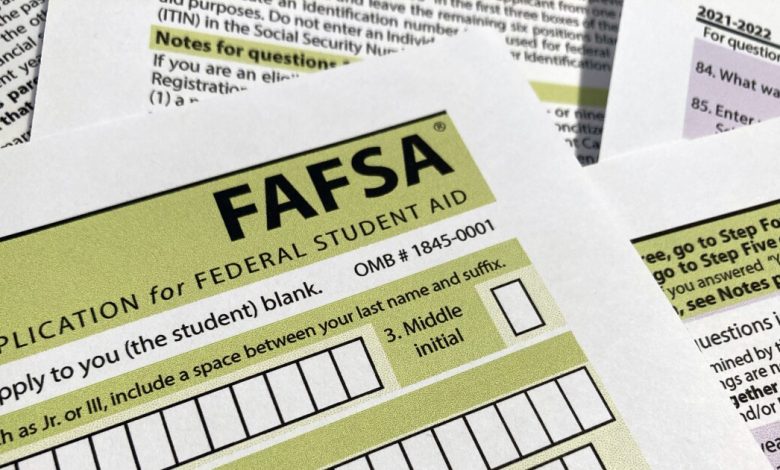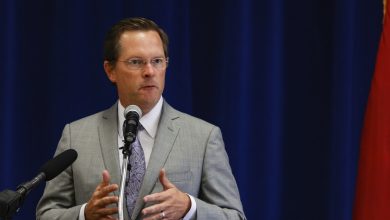Biden Wants to Double the Maximum Pell Grant. What Difference Would That Make?

A $13,000 Pell Grant would just about fully cover today’s average annual cost of attendance for community-college students. Students at public four-year institutions would have more than half of their tuition, fees, room, and board paid for.
That’s what President Biden called for last month in his latest budget proposal: a doubling of the maximum Pell Grant by 2029. While it isn’t likely to pass, affordability advocates say they hope the president’s ambitious proposal will amplify an important conversation about the federal student-aid program.
The Pell Grant has helped low-income students afford college for 50 years. But Biden and higher-ed advocates say it isn’t doing that job as well as it could be.
Biden has cited a striking statistic: In 1980 the maximum Pell award covered nearly 80 percent of tuition, fees, room, and board at a four-year public university. In 2020 it covered less than 30 percent of those costs.
Congress has recently tried to keep the Pell Grant in line with inflation by making small increases, of $100 and $200, in the maximum award. In the latest omnibus spending package, passed in March, lawmakers approved a $400 increase — the largest single boost for the Pell in more than a decade. The maximum Pell Grant increased from $6,495 to $6,895, and the minimum award grew from $650 to $690.
The Pell Grant program has long enjoyed bipartisan support. Republicans like it because it’s a voucher program that puts the money in the hands of students, who decide how and where to spend it; Democrats like it because it is so focused on low-income students, said Terry W. Hartle, senior vice president for government relations and public affairs at the American Council on Education.
Currently, a key obstacle is cost: While a number of Democratic members of Congress are pushing for increases in the Pell Grant, Republicans have said they are wary of any new government spending amid rising inflation. During a hearing last year, Republicans on the House Education and Labor Committee also said they didn’t think doubling the Pell Grant would actually make college more affordable, and suggested that colleges would simply increase their tuition in response.
Fighting Inequity
Shoring up the Pell program is one of the most effective ways to fight inequity in higher education, affordability advocates say, because it’s targeted at students who most need help.
According to the National Association of Student Financial Aid Administrators, increasing Pell is closely connected to racial and social justice. In the 2015-16 academic year, 58 percent of Black undergraduates and 47 percent of Hispanic undergraduates received a federal Pell Grant, compared with 32 percent of white undergraduates. Just over 80 percent of Pell recipients in 2017-18 had an annual family income of less than $40,000.
“When we’re talking about how to make sure that we’re distributing financial aid equitably, Pell is really the best way to do that,” said Rachel Gentry, the association’s director of government relations. “It’s also not like we have to get a new program up and off the ground. The Pell Grant program already exists, and it’s already targeting aid to the lowest-income students.”
As is stands, though, the maximum Pell Grant doesn’t even cover the average cost of in-state tuition at a four-year public university, let alone other costs. While low-income students often receive state and institutional aid on top of their Pell award, that’s not always enough.
Pell Grant recipients are more than twice as likely as other students to have student loans, according to the American Council on Education.
“If low-income students are fully qualified and eligible to attend four-year institutions, and they want to attend their four-year institution, they should be able to do so without having to not only borrow the full amount of loans, but also having to work many hours or having their low-income parents take out loans,” said Rachel Fishman, deputy director for research in New America’s education-policy program.
“What I’d like to see,” Fishman continued, “is a program that’s funded at least up to a level where the access and opportunity of a four-year degree is not just only for middle-class and upper-income Americans anymore.”
In 2018-19, less than one-fourth of four-year public institutions were affordable to students who received a Pell Grant, according to the National College Attainment Network. At those institutions, the average amount of unmet financial need for Pell recipients was $2,524.
Similarly, only 41 percent of two-year public institutions were affordable for Pell recipients, with an average unmet financial need of $855. (The organization calculates affordability by determining whether a college’s total costs, plus $300 in emergency expenses, would be covered by all available sources of student aid, federal work-study, and the expected family contribution.)
“The program has been underfunded for so long,” Fishman said, “and tuition and associated expenses have increased so fast, that there’s still a wide gap for a lot of students where that Pell Grant ends.”
Shoring Up the Program
Some policy experts are skeptical of arguments that the Pell Grant program hasn’t kept up with the rising cost of college. Jason D. Delisle, a senior policy fellow in the Center on Education Data and Policy at the Urban Institute, wrote in an analysis last year that grant aid from all sources, including Pell, nearly doubled from the 1980s to the 2010s, offsetting most of the increase in tuition and fees during that period. The real problem, Delisle wrote, was the increase in students’ housing costs.
While lawmakers’ appetite to spend federal dollars has declined since a spending boom earlier in the pandemic, Fishman doesn’t believe that should stand in the way of shoring up the Pell Grant. A crisis like the pandemic exacerbated the inequities of college affordability, she said.
“To me this timing is even more critical,” said Kim Cook, chief executive of the National College Attainment Network, known as NCAN. “This has been a policy goal for NCAN pre-pandemic, but if anything about the pandemic has been a lesson, it’s that this is really about the exacerbated inequities of affordability and the need to really look at which programs and proposals best target those needs and support those students the best way.”
Some progressive legislators are adamant that if doubling the Pell doesn’t happen in the next budget cycle, they’ll continue to push for it. But its future could depend on whether cost-conscious Republicans take control of one or both chambers of Congress in the coming midterm elections. In the past, said Hartle, of the American Council on Education, Republicans have supported increases in the Pell as part of much smaller federal budgets.
Some Republicans are also skeptical that doubling the Pell would be best for students. Rep. Greg Murphy, a North Carolina Republican on the education committee, believes colleges, not students, are the main beneficiaries of the grant program. “Comprehensive reform of the HEA’s accountability network will do more to help students in the long term than pouring money into a failing system,” he said during a hearing, referring to the Higher Education Act. His argument suggests that increasing student aid leads to higher tuition costs, but research on the idea is inconclusive.
Despite the long odds of doubling the maximum Pell in the near future, having Biden include that goal as a policy priority has energized the higher-education community, Hartle said. ACE and other higher-ed advocates are cautiously optimistic.
“You have to start somewhere,” Hartle said, “and this is an indispensable first step towards achieving those goals.”
Source link






